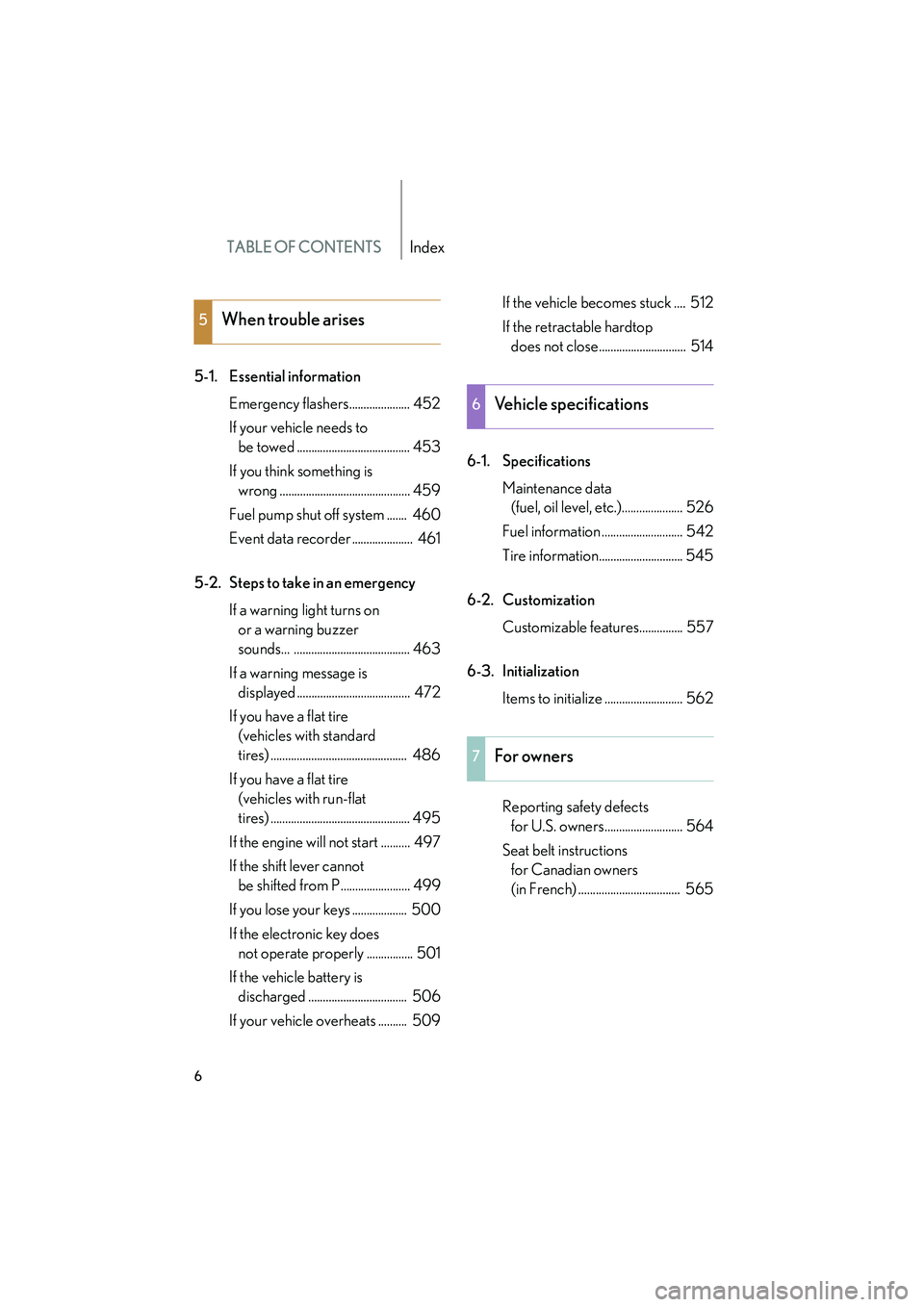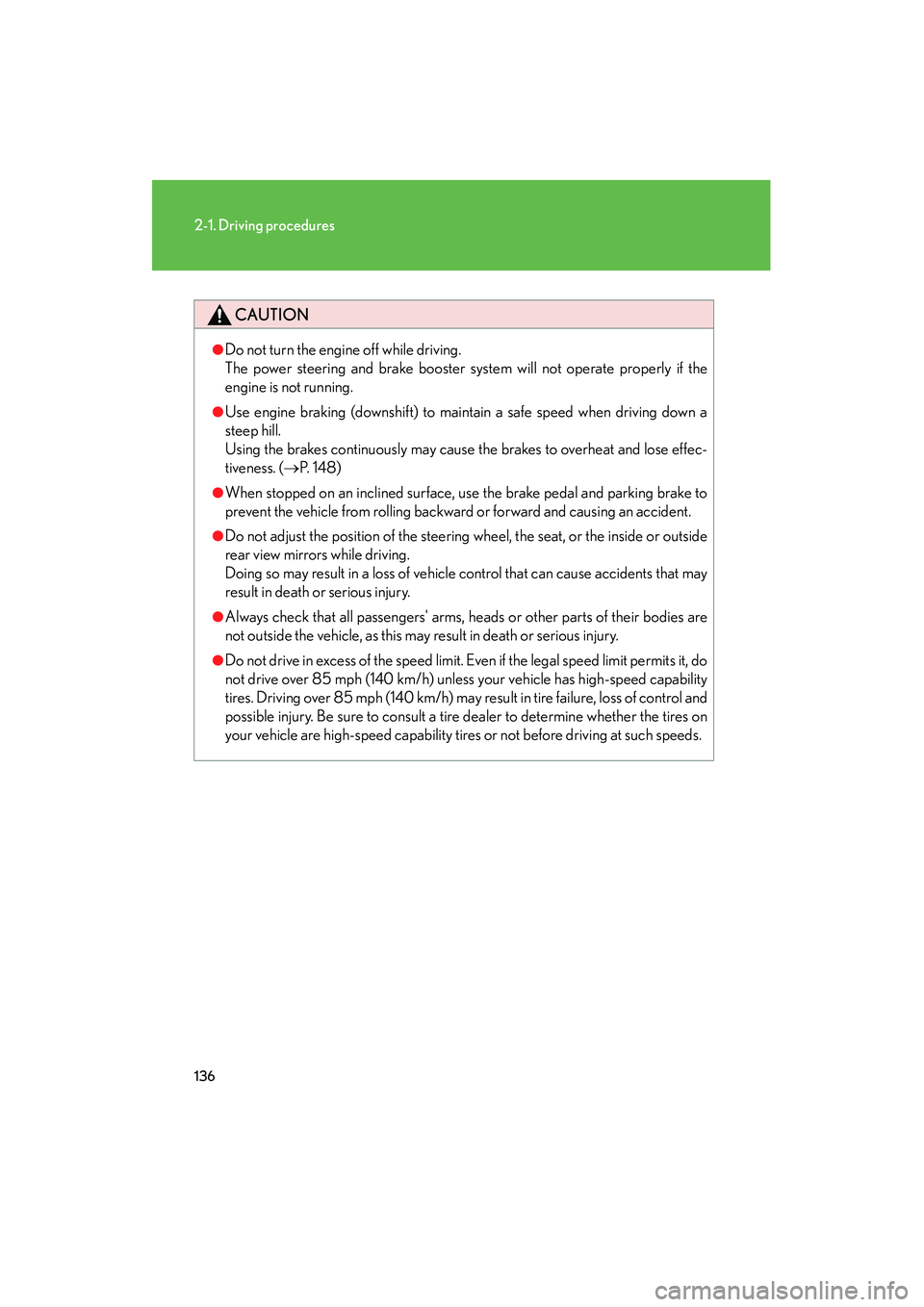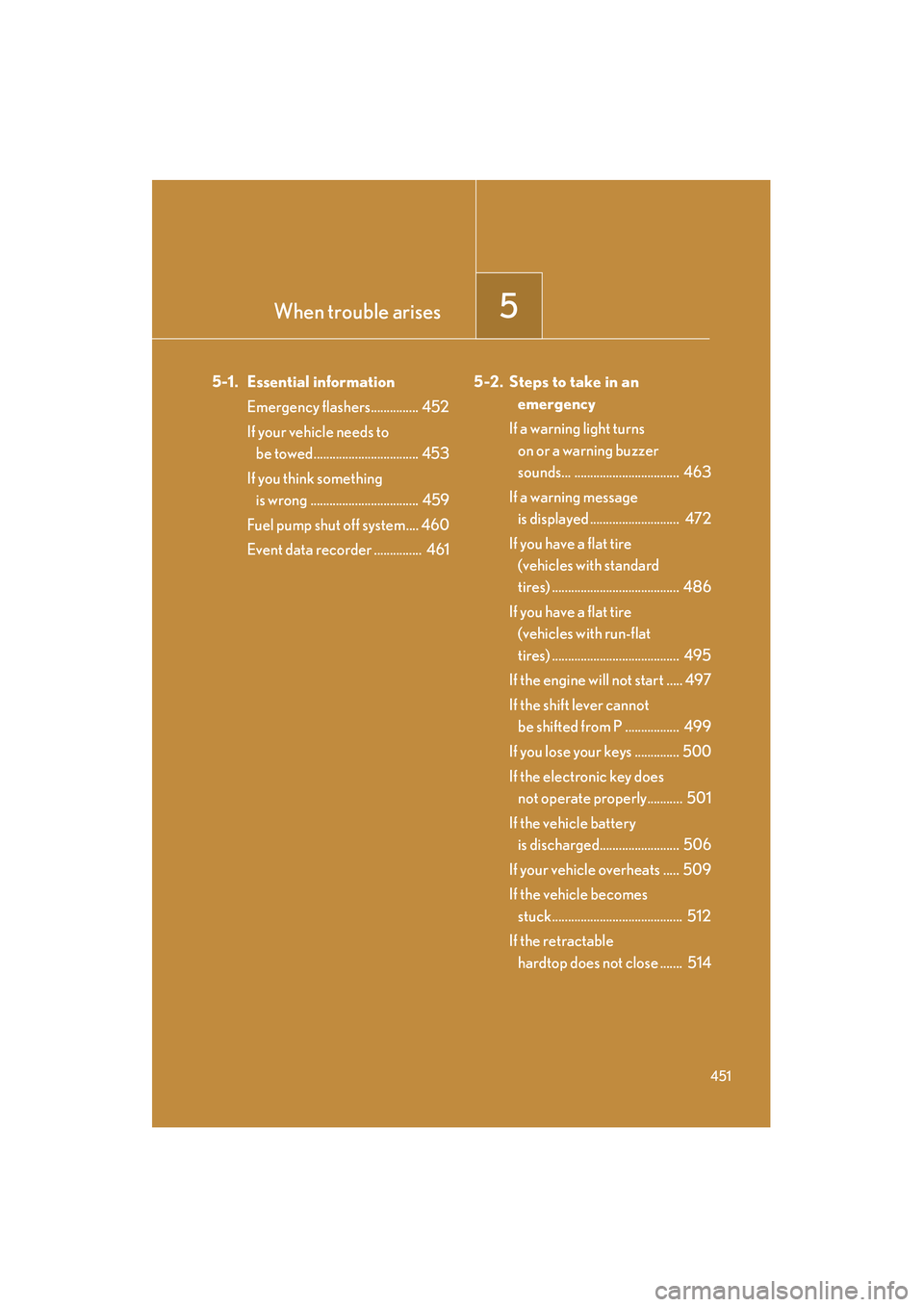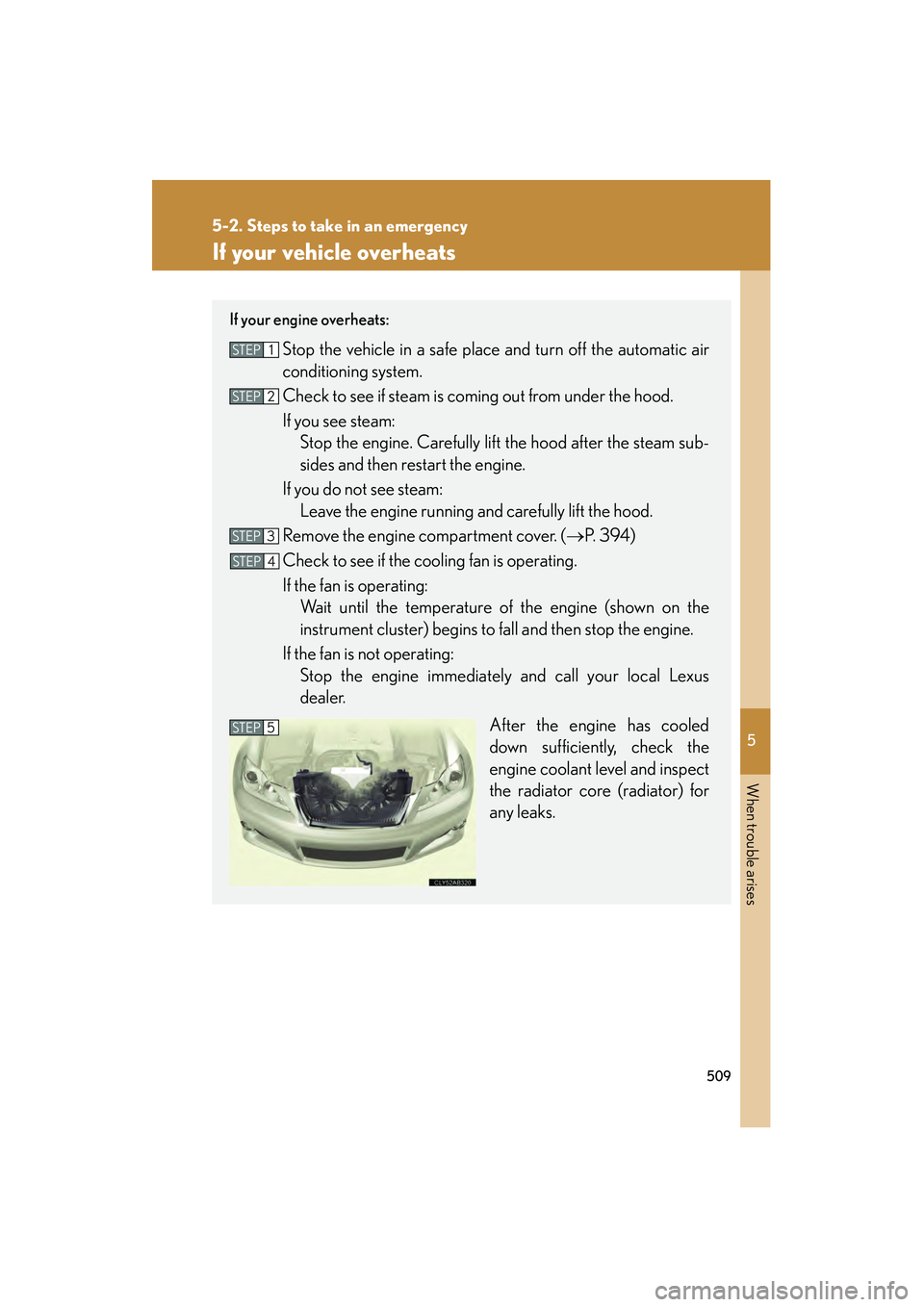engine overheat Lexus IS250C 2010 Owner's Manual
[x] Cancel search | Manufacturer: LEXUS, Model Year: 2010, Model line: IS250C, Model: Lexus IS250C 2010Pages: 586, PDF Size: 31.62 MB
Page 7 of 586

TABLE OF CONTENTSIndex
10_IS250C/350C_U
6
5-1. Essential informationEmergency flashers..................... 452
If your vehicle needs to be towed ....................................... 453
If you think something is wrong ............................................. 459
Fuel pump shut off system ....... 460
Event data recorder ..................... 461
5-2. Steps to take in an emergency If a warning light turns on or a warning buzzer
sounds... ........................................ 463
If a warning message is displayed ....................................... 472
If you have a flat tire (vehicles with standard
tires) ............................................... 486
If you have a flat tire (vehicles with run-flat
tires) ................................................ 495
If the engine will not start .......... 497
If the shift lever cannot be shifted from P........................ 499
If you lose your keys ................... 500
If the electronic key does not operate properly ................ 501
If the vehicle battery is discharged .................................. 506
If your vehicle overheats .......... 509 If the vehicle becomes stuck .... 512
If the retractable hardtop
does not close.............................. 514
6-1. Specifications Maintenance data (fuel, oil level, etc.)..................... 526
Fuel information ............................ 542
Tire information............................. 545
6-2. Customization Customizable features............... 557
6-3. Initialization Items to initialize ........................... 562
Reporting safety defects for U.S. owners........................... 564
Seat belt instructions for Canadian owners
(in French) ................................... 565
5When trouble arises
6Vehicle specifications
7For owners
Page 137 of 586

136
2-1. Driving procedures
10_IS250C/350C_U
CAUTION
●Do not turn the engine off while driving.
The power steering and brake booster system will not operate properly if the
engine is not running.
●Use engine braking (downshift) to maintain a safe speed when driving down a
steep hill.
Using the brakes continuously may cause the brakes to overheat and lose effec-
tiveness. (→P. 1 4 8 )
●When stopped on an inclined surface, use the brake pedal and parking brake to
prevent the vehicle from rolling backward or forward and causing an accident.
●Do not adjust the position of the steering wheel, the seat, or the inside or outside
rear view mirrors while driving.
Doing so may result in a loss of vehicle control that can cause accidents that may
result in death or serious injury.
●Always check that all passengers' arms, heads or other parts of their bodies are
not outside the vehicle, as this may result in death or serious injury.
●Do not drive in excess of the speed limit. Even if the legal speed limit permits it, do
not drive over 85 mph (140 km/h) unless your vehicle has high-speed capability
tires. Driving over 85 mph (140 km/h) may result in tire failure, loss of control and
possible injury. Be sure to consult a tire dealer to determine whether the tires on
your vehicle are high-speed capability tires or not before driving at such speeds.
Page 140 of 586

139
2-1. Driving procedures
2
When driving
10_IS250C/350C_U
CAUTION
■When taking a nap in the vehicle
Always turn the engine off. Otherwise, you may accidentally move the shift lever or
depress the accelerator pedal, which could cause an accident or fire due to engine
overheating. Additionally, if the vehicle is parked in a poorly ventilated area, exhaust
gases may collect and enter the vehicle, leading to death or a serious health hazard.
■When braking the vehicle
●When the brakes are wet, drive more cautiously.
Braking distance increases when the brakes are wet, and may cause one side of
the vehicle to brake differently than the other side. Also the parking brake may
not securely hold the vehicle.
●If the power brake assist function does not operate, do not follow other vehicles
closely and avoid downhills or sharp turns that require braking.
In this case, braking is still possible, but it will require more force on the pedal than
usual. Braking distance may also increase.
●Do not pump the brake pedal if the engine stalls.
Each push on the brake pedal uses up the reserve for the power-assisted brakes.
●The brake system consists of 2 individual hydraulic systems: if one of the systems
fails, the other will still operate. In this case, the brake pedal should be depressed
more firmly than usual and braking distance becomes longer.
Do not drive your vehicle with only a single brake system. Have your brakes fixed
immediately.
Page 165 of 586

164
2-2. Instrument cluster
10_IS250C/350C_U
■Speed indicator display conditions and vehicle speed setting range
Vehicle speed setting range: Approximately 30 to 100 mph (approximately 50 to 160 km/h)
When the maximum speed is selected, the speed indicator comes on only in red.
■Tacho indicator display conditions and engine speed setting range
Engine rpm setting range: Approximately 2000 to 6500 rpm (r/min)
When the maximum rpm is selected, the tacho indicator comes on only in red.
■The brightness of the instrument panel lights
When the headlight switch is turned to on, the brightness will be reduced slightly
unless the control dial is turned fully clockwise.
NOTICE
■To prevent damage to the engine and its components
●Do not let the indicator needle of the ta chometer enter the red zone, which indi-
cates the maximum engine speed.
●The engine may be overheating if the temperature gauge is in the red zone (H). In
this case, immediately stop the vehicle in a safe place, and check the engine after
it has cooled completely. ( →P. 5 0 9 )
Page 183 of 586

182
2-3. Operating the lights and windshield wipers
10_IS250C/350C_U
Headlight cleaner switch∗
■The headlight cleaner can be operated when
When the “ENGINE START STOP” switch is in IGNITION ON mode and the
headlight switch is turned on.
■Windshield washer linked operation
Only for the first time when the windshield washer is operated after the “ENGINE
START STOP” switch is turned to IGNITION ON mode with the headlights on, the
headlight cleaners will also operate once. (→P. 177)
NOTICE
■When the washer fluid tank is empty
Do not use this function when the washer fluid tank is empty. This may cause the
washer fluid pump to overheat.
Washer fluid can be sprayed on the headlights.
Press the switch to clean the
headlights.
∗: If equipped
Page 209 of 586

208
2-4. Using other driving systems
10_IS250C/350C_U
■EPS operation sound
When the steering wheel operates, a motor sound (whirring sound) may be heard.
This does not indicate a malfunction.
■Reduced effectiveness of EPS
The effectiveness of EPS is reduced to prevent the system from overheating when
there is frequent steering input over an extended period of time. The steering wheel
may feel heavy as a result. Should this occur, refrain from excessive steering input or
stop the vehicle and turn the engine OFF. The system should return to normal within
10 minutes.
CAUTION
■The ABS does not operate effectively when
●The limits of tire gripping performance have been exceeded.
●The vehicle hydroplanes while driving at high speed on the wet or slick road.
■Stopping distance when the ABS is operating will exceed that of normal condi-
tions
The ABS is not designed to shorten the vehicle’s stopping distance. Always main-
tain a safe distance from the vehicle in front of you in the following situations.
●When driving on dirt, gravel or snow-covered roads
●When driving with tire chains
●When driving over bumps in the road
●When driving over roads with potholes or roads with uneven roads
Page 354 of 586

353
3-7. Other interior features
3
Interior features
10_IS250C/350C_U
Cigarette lighter
■The cigarette lighter can be used when
The “ENGINE START STOP” switch is in ACCESSORY or IGNITION ON mode.
CAUTION
■When not in use
Keep the lid closed.
Injuries may result in the event of an accident or sudden braking.
■To avoid burns or fires
●Do not touch the metal parts of the cigarette lighter.
●Do not hold the cigarette lighter down. It could overheat and cause a fire.
●Do not insert anything other than the cigarette lighter into the outlet.
Push the back part of the lid to
open, and push the cigarette
lighter down.
The cigarette lighter will pop up
when it is ready for use.
Page 358 of 586

357
3-7. Other interior features
3
Interior features
10_IS250C/350C_U
CAUTION
■Burns
●Use caution when seating the following persons in a seat with the seat heater on
to avoid the possibility of burns:
• Babies, small children, the elderly, the sick and the disabled
• Persons with sensitive skin
• Persons who are fatigued
• Persons who have taken alcohol or drugs that induce sleep (sleeping drugs,cold remedies, etc.)
●Do not cover the seat with anything when using the seat heater.
Using the seat heater with a blanket or cushion increases the temperature of the
seat and may lead to overheating.
NOTICE
■To prevent seat heaters and ventilators damage
Do not put unevenly weighted objects on the seat and do not stick sharp objects
(needles, nails, etc.) into the seat.
■To prevent battery discharge
Turn the switches off when the engine is off.
Page 452 of 586

When trouble arises5
451
10_IS250C/350C_U
5-1. Essential informationEmergency flashers............... 452
If your vehicle needs to be towed................................. 453
If you think something is wrong .................................. 459
Fuel pump shut off system.... 460
Event data recorder ............... 461 5-2. Steps to take in an
emergency
If a warning light turns on or a warning buzzer
sounds... ................................. 463
If a warning message is displayed ............................ 472
If you have a flat tire (vehicles with standard
tires) ........................................ 486
If you have a flat tire (vehicles with run-flat
tires) ........................................ 495
If the engine will not start ..... 497
If the shift lever cannot be shifted from P ................. 499
If you lose your keys .............. 500
If the electronic key does not operate properly........... 501
If the vehicle battery is discharged......................... 506
If your vehicle overheats ..... 509
If the vehicle becomes stuck......................................... 512
If the retractable hardtop does not close ....... 514
Page 510 of 586

5
When trouble arises
509
5-2. Steps to take in an emergency
10_IS250C/350C_U
If your vehicle overheats
If your engine overheats:
Stop the vehicle in a safe place and turn off the automatic air
conditioning system.
Check to see if steam is coming out from under the hood.
If you see steam: Stop the engine. Carefully lift the hood after the steam sub-
sides and then restart the engine.
If you do not see steam: Leave the engine running and carefully lift the hood.
Remove the engine compartment cover. ( →P. 394)
Check to see if the cooling fan is operating.
If the fan is operating: Wait until the temperature of the engine (shown on the
instrument cluster) begins to fall and then stop the engine.
If the fan is not operating: Stop the engine immediately and call your local Lexus
dealer.
After the engine has cooled
down sufficiently, check the
engine coolant level and inspect
the radiator core (radiator) for
any leaks.STEP1
STEP2
STEP3
STEP4
STEP5